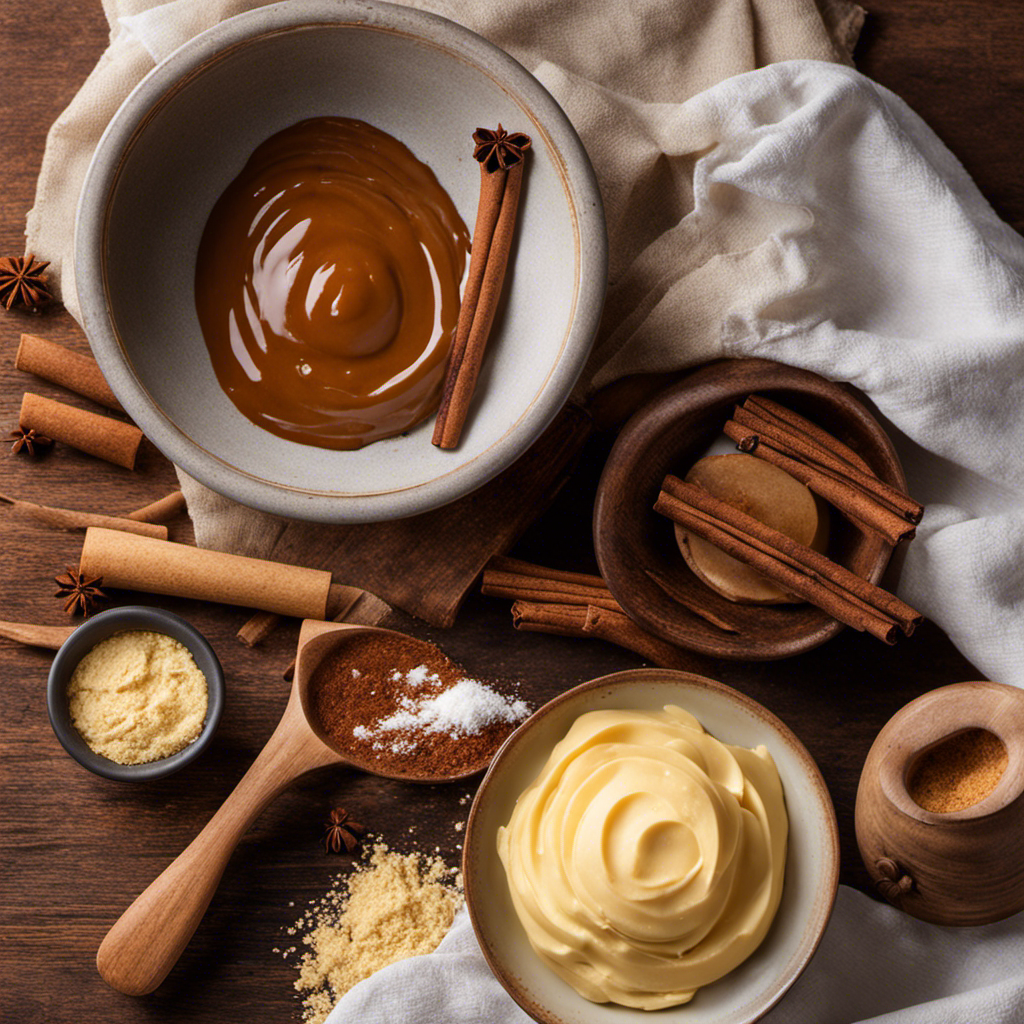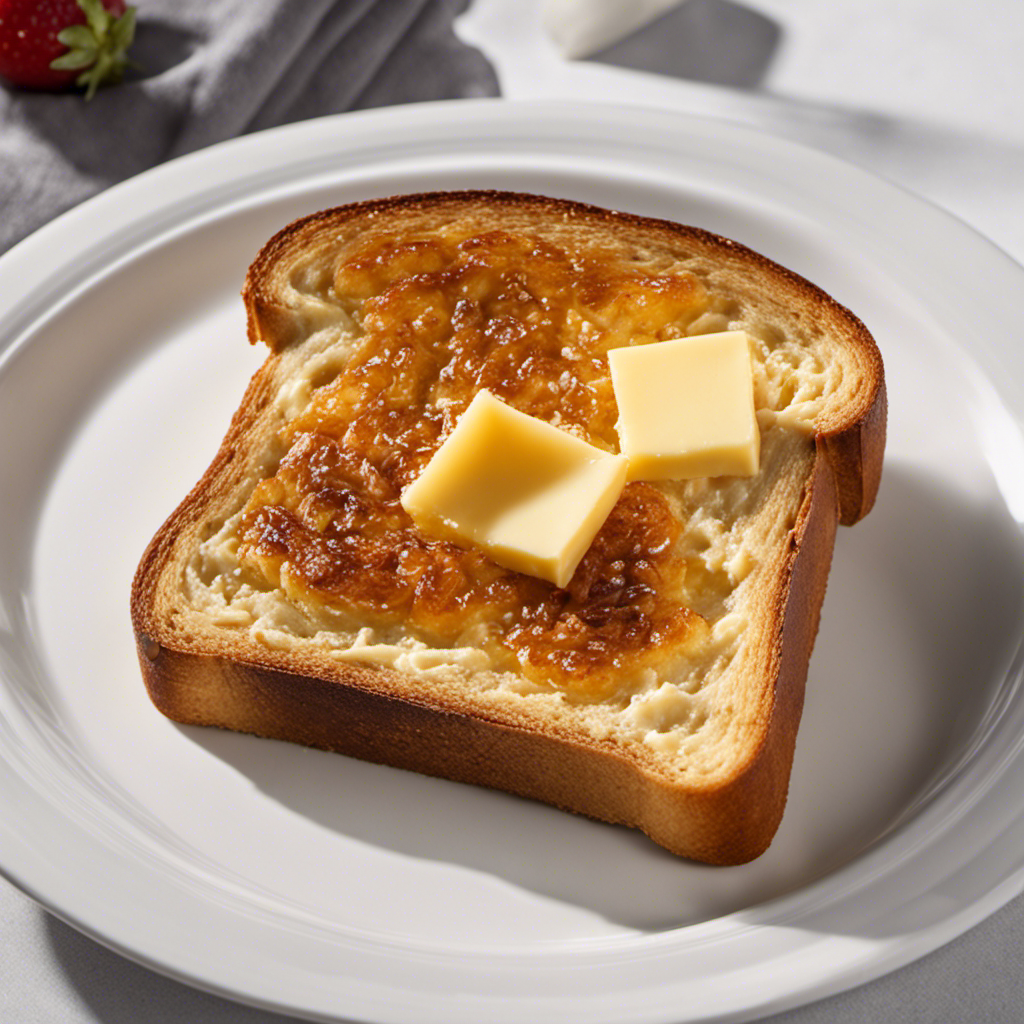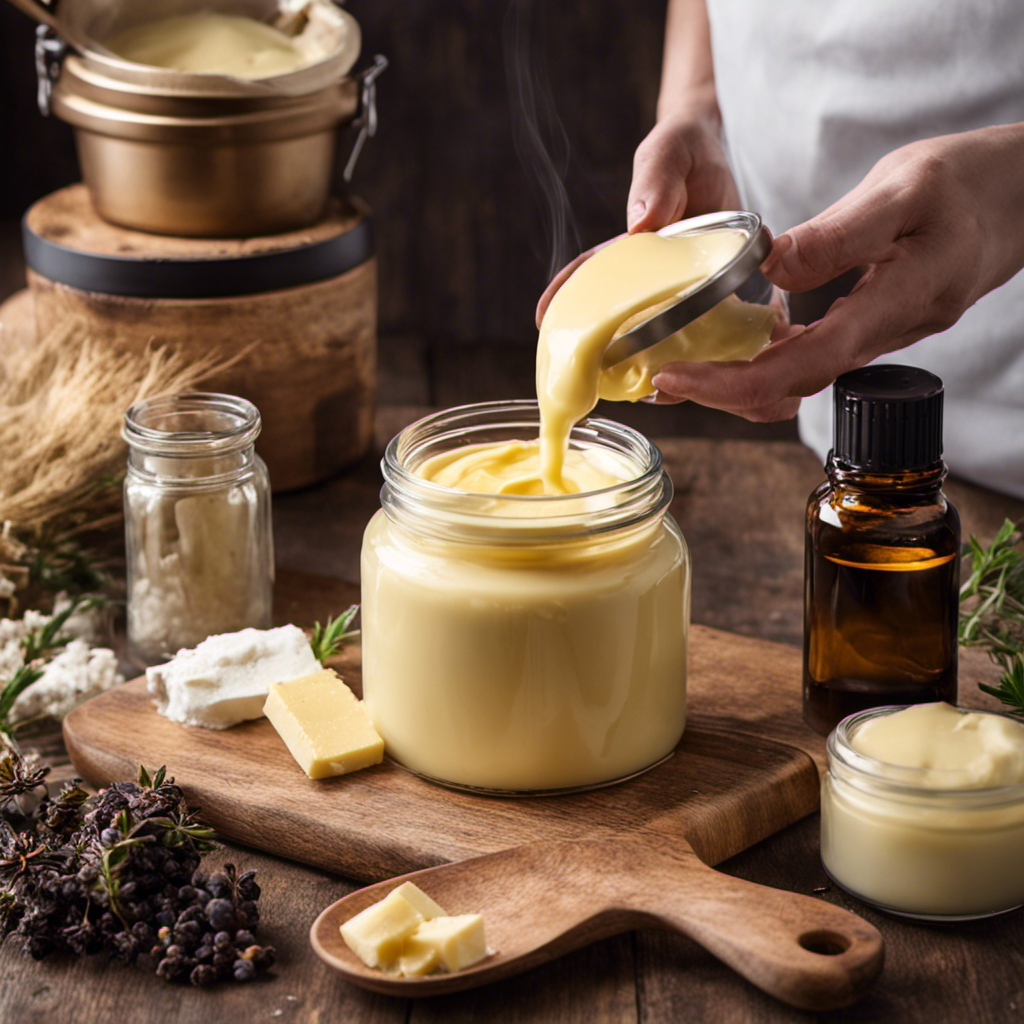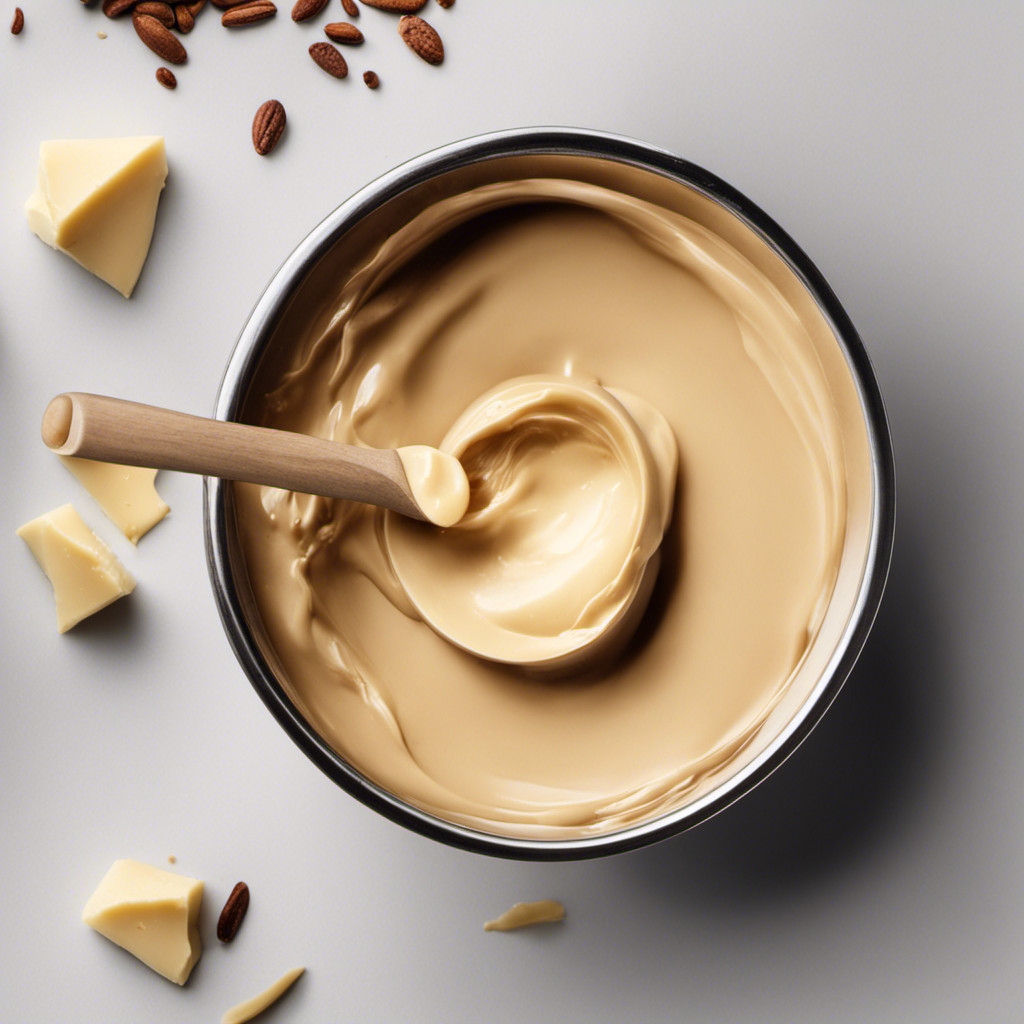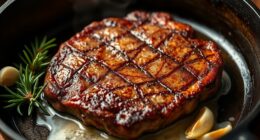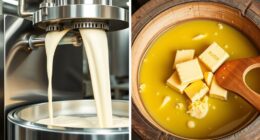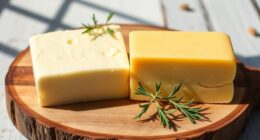I love butter, and I love cinnamon. So, naturally, the idea of combining the two into a delectable spread is pure genius. But here’s the catch: I don’t want to use powdered sugar. Is it even possible to make cinnamon butter without it?
Well, I’m here to tell you that it absolutely is. In this article, I’ll guide you through the process of creating a rich and flavorful cinnamon butter without the need for powdered sugar. Trust me, your taste buds are in for a treat.
Key Takeaways
- Cinnamon butter adds a warm and spicy taste to butter while providing anti-inflammatory properties and aiding digestion.
- When making cinnamon butter, it is important to choose high-quality unsalted butter, preferably from grass-fed cows or European-style butter for a richer and smoother consistency.
- Natural sweeteners like honey and maple syrup are healthier alternatives to powdered sugar, offering antioxidants and trace minerals with a lower glycemic index.
- To balance flavors effectively, consider adding vanilla extract or cayenne pepper for enhanced sweetness or heat, and experiment with other spices like nutmeg or cardamom for depth and complexity.
Why Use Cinnamon in Butter
If you’re looking to enhance the flavor of your butter, you should definitely consider using cinnamon.
Not only does cinnamon add a warm and spicy taste to your butter, but it also comes with a range of health benefits.
Cinnamon is known for its anti-inflammatory properties, which can help reduce inflammation in the body. It is also believed to aid in digestion and regulate blood sugar levels.
In addition to its health benefits, cinnamon butter can be used in a variety of ways.
Spread it on toast, pancakes, or waffles for a delicious and fragrant breakfast. Use it as a topping for baked goods, like cinnamon rolls or apple pie. Or even melt it over roasted vegetables for a unique and flavorful twist.
The possibilities are endless with cinnamon butter!
Choosing the Right Butter for Cinnamon Butter
When choosing the right butter for your cinnamon butter, opt for a high-quality, unsalted variety. This will allow the flavors of the cinnamon to shine through without being overpowered by saltiness.
Look for butter that is made from grass-fed cows, as it tends to have a richer and creamier texture. Additionally, consider using European-style butter, which has a higher butterfat content and will result in a smoother and more velvety cinnamon butter.
To achieve a smooth texture, make sure your butter is at room temperature before blending in the cinnamon. This will help the spices incorporate evenly into the butter and prevent any clumps.
The Power of Natural Sweeteners
Using natural sweeteners, such as honey or maple syrup, can add a subtle sweetness to your cinnamon butter. Not only do these alternatives provide a healthier option compared to powdered sugar, but they also bring their own unique flavors to the table.
Here are three reasons why using natural sweeteners in your cinnamon butter is a great idea:
-
Health benefits: Unlike refined sugars, natural sweeteners like honey and maple syrup contain antioxidants and trace minerals that can benefit your overall health. They also have a lower glycemic index, meaning they won’t cause a sudden rise in blood sugar levels.
-
Rich flavors: Honey adds a distinct floral sweetness, while maple syrup brings a rich, caramel-like flavor to your cinnamon butter. These natural sweeteners enhance the taste and create a more complex and enjoyable eating experience.
-
Versatility: Natural sweeteners can be easily adjusted to suit your taste preferences. You can add more or less depending on how sweet you want your cinnamon butter to be, allowing you to customize it to your liking.
The Perfect Ratio of Cinnamon to Butter
When it comes to making cinnamon butter, finding the perfect ratio of cinnamon to butter is crucial for achieving that delicious balance of flavors.
I’ve experimented with different combinations and have found that a 2:1 ratio of cinnamon to butter works best.
This allows the cinnamon to shine without overpowering the butter, resulting in a flavorful and spreadable concoction that is perfect for toast, pancakes, and more.
Optimal Cinnamon-To-Butter Ratio
The best ratio of cinnamon to butter for making cinnamon butter without powdered sugar is 1 teaspoon of cinnamon per stick of butter. This measurement ensures a balanced and flavorful spread that is not too overpowering. However, if you prefer a stronger cinnamon flavor, you can adjust the measurement accordingly.
Here are some tips to help you achieve the perfect cinnamon butter:
- Gradually increase the amount of cinnamon if you want a bolder taste.
- Taste test along the way to ensure the desired flavor is achieved.
- Keep in mind that the amount of cinnamon may vary depending on personal preference and the quality of the cinnamon used.
Balancing Flavors Effectively
For a well-rounded flavor, it’s important to find the right balance between the sweetness and spiciness in your cinnamon spread. Balancing flavors effectively is the key to creating a delicious and versatile spread that can be enjoyed in various ways.
One creative way to achieve this balance is by experimenting with different flavor combinations. For example, you can add a touch of vanilla extract to enhance the sweetness or a pinch of cayenne pepper for some heat. You can also try mixing in other spices like nutmeg or cardamom to add depth and complexity to your spread.
By combining these flavors in just the right amounts, you can create a cinnamon spread that is both sweet and spicy, satisfying the taste buds of everyone who tries it.
Now, let’s move on to enhancing spreadability without clumping.
Enhancing Spreadability Without Clumping
To enhance spreadability without clumping, you’ll want to warm up the cinnamon spread slightly before using it. This will help to soften the butter and make it easier to spread onto your favorite bread or toast.
Here are a few tips to improve the texture and spreadability of your cinnamon butter:
- Use room temperature butter: Softened butter is easier to mix and spread, so make sure to take it out of the fridge ahead of time.
- Whip it up: Beat the butter with a hand mixer or stand mixer until it becomes light and fluffy. This will help incorporate air and create a smoother texture.
- Add alternative sweeteners: Instead of using powdered sugar, try using honey, maple syrup, or agave nectar to sweeten your cinnamon butter. These options add a natural sweetness and can help improve the overall texture.
The Secret Ingredient for Extra Flavor
I love experimenting with different flavors in my cooking. One thing I’ve discovered is that unexpected flavor combinations can often lead to amazing results. Whether it’s adding a touch of citrus to a savory dish or incorporating a hint of spice into a sweet treat, these unexpected pairings can truly elevate the taste experience.
When it comes to enhancing the buttery aroma in my dishes, I’ve found that a simple addition can make all the difference. By infusing the butter with herbs or spices, such as thyme or garlic, I can take the aroma to a whole new level. This creates a mouthwatering scent that will have everyone asking for seconds.
Unexpected Flavor Combinations
When experimenting with unexpected flavor combinations, it’s important to consider how different ingredients will complement each other. By combining flavors that are not traditionally paired together, you can create unique taste combinations that will surprise and delight your palate.
Here are three exciting flavor pairings to try:
-
Sweet and Spicy: The combination of sweet and spicy flavors can create a dynamic taste experience. Try adding a touch of chili powder to your favorite dessert for a surprising kick.
-
Savory and Sweet: The contrast between savory and sweet can create a balance that is both satisfying and intriguing. Experiment with adding a sprinkle of sea salt to your favorite sweet treats for a delightful twist.
-
Tangy and Creamy: The tanginess of ingredients like citrus or vinegar can cut through the richness of creamy dishes, adding a refreshing and unexpected element. Consider adding a squeeze of lemon juice to your next creamy pasta dish for a burst of flavor.
Get creative and have fun exploring the world of flavor pairings. You never know what delicious surprises await!
Enhancing the Buttery Aroma
Enhancing the buttery aroma can be achieved by adding a sprinkle of cinnamon to your favorite baked goods. The warm, inviting scent of cinnamon pairs perfectly with the richness of butter, creating a delightful combination that is sure to please your taste buds. But cinnamon doesn’t just enhance the aroma of butter; it also improves the texture, adding a subtle crunch and a touch of sweetness.
To make cinnamon butter, simply mix softened butter with a generous amount of ground cinnamon until well combined. Spread it on toast, pancakes, or waffles for a delicious breakfast treat. You can also use it to add a flavorful twist to your favorite desserts, such as cinnamon buttercream frosting or cinnamon butter cookies. The possibilities are endless when it comes to creative uses for cinnamon butter, so don’t be afraid to experiment and discover new ways to enjoy this aromatic and delectable ingredient.
| Creative Uses for Cinnamon Butter | ||
|---|---|---|
| Cinnamon Swirl Bread | Cinnamon Roll Pancakes | Cinnamon Butter Popcorn |
A Step-by-Step Guide to Making Cinnamon Butter
First, gather your ingredients for making cinnamon butter without powdered sugar. Here’s what you’ll need:
- Unsalted butter: Make sure it’s softened, so it’s easier to mix with the other ingredients.
- Alternative sweetener: Instead of powdered sugar, you can use options like honey, maple syrup, or agave nectar. Choose the one that suits your taste preferences.
- Ground cinnamon: This is the star ingredient that gives the butter its distinct flavor.
To make the cinnamon butter, simply mix the softened butter with your chosen sweetener and a touch of vanilla for added depth of flavor. Whip it all together until well combined, and voila! You have a delicious spread that’s perfect for pancakes, toast, or even baked goods.
Now that you’ve made your homemade cinnamon butter, let’s move on to the next step: storing and serving it.
Storing and Serving Your Homemade Cinnamon Butter
Now that you’ve made your delicious homemade cinnamon butter, it’s important to know how to store it properly to ensure its freshness and flavor.
One of the best ways to store cinnamon butter is by placing it in an airtight container and keeping it in the refrigerator. This will help to maintain its creamy texture and prevent any spoilage.
When it comes to serving your cinnamon butter, there are plenty of creative ideas to explore.
One option is to spread it on warm toast or muffins for a delightful breakfast treat. You can also use it as a topping for pancakes or waffles, adding a burst of cinnamon flavor to your morning meal.
Another idea is to mix it into oatmeal or yogurt for a tasty twist. And if you’re feeling adventurous, try using it as a filling for pastries or as a frosting for cakes and cupcakes.
The possibilities are endless!
Overall, by following these storing tips and exploring creative serving ideas, you can enjoy your homemade cinnamon butter to the fullest.
Frequently Asked Questions
Can I Use Margarine Instead of Butter for Making Cinnamon Butter?
Yes, you can use margarine instead of butter for making cinnamon butter. Margarine is a suitable alternative to butter and will still give your cinnamon butter a delicious and creamy texture.
Can I Use Brown Sugar Instead of Natural Sweeteners for Making Cinnamon Butter?
Yes, you can use brown sugar instead of natural sweeteners for making cinnamon butter. Brown sugar adds a rich, caramel flavor. Just be aware that it may make the butter slightly grainy.
Can I Add Other Spices Like Nutmeg or Ginger to My Cinnamon Butter?
Adding additional spices like nutmeg or ginger to cinnamon butter can enhance its flavor profile. However, it’s important to consider the balance of flavors and not overpower the cinnamon. Experimenting with different combinations can lead to delicious results.
How Long Will Homemade Cinnamon Butter Last in the Refrigerator?
In the fridge, homemade cinnamon butter can last for up to two weeks. To prolong its shelf life, store it in an airtight container. Spread it on warm toast and savor the rich, comforting flavors.
Can I Use Cinnamon Extract Instead of Ground Cinnamon for Making Cinnamon Butter?
Yes, you can use cinnamon extract instead of ground cinnamon for making cinnamon butter. However, ground cinnamon has the benefit of adding texture and flavor to recipes, so it’s often preferred in baking.
Conclusion
In conclusion, making homemade cinnamon butter without powdered sugar is like embarking on a culinary adventure. It’s a journey that allows you to explore the power of natural sweeteners and discover the perfect balance of flavors.
With the right choice of butter and the secret ingredient for that extra oomph, you can create a delicious spread that will elevate your breakfast or snack time to new heights.
So, why settle for store-bought when you can enjoy the pleasure of crafting your own cinnamon butter masterpiece? Let your taste buds be your guide, and let your creativity run wild in the kitchen!
